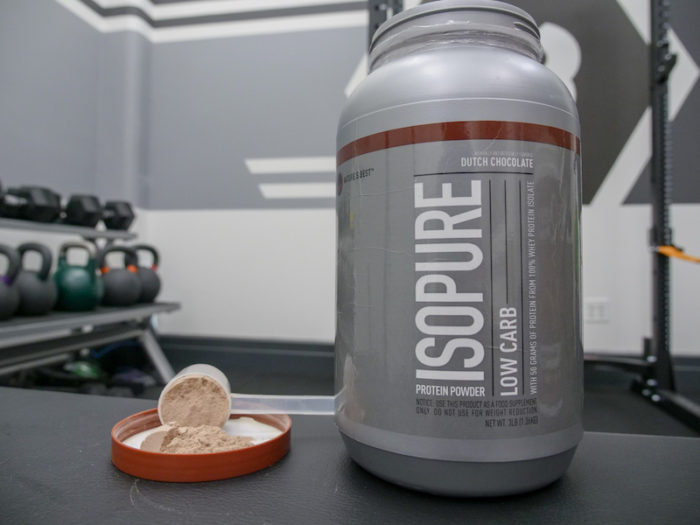You know that if you want to build or retain muscle, it’s important to consume a good amount of protein per day. (Here’s how much protein is ideal, if you’re unsure.)
But with protein typically being the most costly of the three macros and the toughest to come by when you’re out and about — there are no shortage of packaged snacks that are mostly carbs and fat — it makes sense that protein powders are the most popular muscle building products on the planet.
Whey is far and away the most common, but how do you decide on one of the countless brands? Here we’re running down a quick and easy list of the three most common types of whey you’ll find so you can decide on the right one for your needs.
[Looking for the best option? Check out our picks for the best whey protein!]

Where Does Whey Come From?
First, a quick lesson. Milk contains two kinds of protein: whey and casein. When you add acid or enzymes to milk, it separates out the whey from the casein. About 80 percent of the protein is casein, which is used to make cheese — that’s why it’s a little more expensive and why the biggest protein powder producers on Earth are cheese companies like Glanbia.(1)
But whey is an extraordinarily high quality protein that’s packed with muscle building amino acids like leucine, and since we learned to dry out the whey and package it in tubs, we wound up with one of the most convenient and inexpensive sources of protein you can consume.(2)
[Learn more about the difference between whey vs casein!]

[Read our review of the most popular protein, Optimum Nutrition Gold Standard Whey.]
Whey Concentrate Benefits
- Most inexpensive
- Highest in fat and carbs
- May be best for immunity
This is the most basic and least processed form of whey, which is why it’s the cheapest. Of all the types of whey this one has the most carbohydrates, sugar, fat, and cholesterol. That’s not to say it’s low in protein — you’ll typically get 3 or 4 grams of carbs and fat for every 20 to 25 grams of protein. But the extra carbs mean it’s sometimes avoided by folks with lactose sensitivities.
Technically, the USDA notes whey concentrate only needs to have a minimum of 11 percent protein, although the vast majority of whey supplements are at least 60 percent whey according to their nutrition labels. But it’s important to remember that the US government doesn’t regulate supplements or their protein content, which is why many prefer whey that’s third party tested.
Some people prefer whey concentrate because of immunoglobulins, antibodies that may help to improve your immunity.(3) When we asked biochemist Dr. Trevor Kashey about this, he opined,
“I would agree it has the immunoglobulins in it, but it doesn’t mean it makes it through your digestive tract nor does it mean that it’s intact and functional when you purchase it. That’s just something to keep in mind: the higher purity something is, the more processed its been, the less activity it’s going to have on a biological level.”
So whey concentrate might have immunoglobulins but we don’t have much data on whether or not they’re present or active by the time you scoop into your protein tub.
[The popular isolate, Isopure Low Carb.]
Whey Isolate Benefits
- Lower in fat and carbs than isolate
- Maybe better for lactose sensitivities
Whey isolate is further processed in such a way that much of the carbohydrates and fat are removed. This is why it’s typically more expensive, but it delivers an extraordinarily high amount of protein, with some whey isolates claiming to be completely carb- and fat-free. This also means it’s typically easier to digest for people with lactose sensitivities.
If you’re someone who has a particularly strict diet, whey isolate is often preferred. For someone who needs 200 grams of protein and under 50 grams of carbs in a day, for example, the three or so grams of carbs in a scoop of concentrate can really add up. For this reason, one might consider whey isolate more versatile, although for the average person the difference is quite negligible.
[Dymatize Iso-100 is partly made from hydrolyzed whey.]
Whey Hydrolysate Benefits
- Digests the fastest
- The most expensive
- May be useful for higher level athletes
Also called hydrolyzed whey, this is the priciest of the three forms of protein. For this one, the whey is partly broken down by enzymes or acids to the point that many label it “pre-digested.” This is why it can be easier to consume for some people with digestive problems and because many of the peptide bonds and large proteins are reduced down to free amino acids, it can be helpful for people with milk allergies.(4) (The extra free amino acids can make the taste pretty bitter, though.)
It’s also why it digests very quickly — hydrolyzed whey breaks down fast and sends amino acids to your muscles more rapidly than the other forms of whey.(4) This is the reason it’s highly prized by some top level athletes: indeed, one study published in the Journal of Science and Medicine in Sport found that out of 28 athletes working out twice per day, those taking hydrolyzed whey were able to recover their power more quickly than the participants who were taking whey isolate.(5)

Wrapping Up
For the average person, whey can be extremely valuable in building muscle. It has a complete amino acid profile that’s extraordinarily high in the muscle-friendly amino acid leucine, and if a few grams of lactose and fat don’t bother you, you’re unlikely to need anything fancier than whey concentrate.
However, if digestion speed, allergies, or protein density are priorities, then you may find it worth the extra cash to invest in isolate or hydrolysate. Just speak with a doctor if you’re concerned about any reactions.
Featured image via Dan_photography/Shutterstock
References
1. Bendtsen LQ, et al. Effect of dairy proteins on appetite, energy expenditure, body weight, and composition: a review of the evidence from controlled clinical trials. Adv Nutr. 2013 Jul 1;4(4):418-38.
2. Wolfe RR. Update on protein intake: importance of milk proteins for health status of the elderly. Nutr Rev. 2015 Aug;73 Suppl 1:41-7.
3. Bell SJ. Whey protein concentrates with and without immunoglobulins: a review.J Med Food. 2000 Spring;3(1):1-13.
4. Potier M, et al. Comparison of digestibility and quality of intact proteins with their respective hydrolysates. J AOAC Int. 2008 Jul-Aug;91(4):1002-5.
5. Buckley JD, et al. Supplementation with a whey protein hydrolysate enhances recovery of muscle force-generating capacity following eccentric exercise. J Sci Med Sport. 2010 Jan;13(1):178-81.

